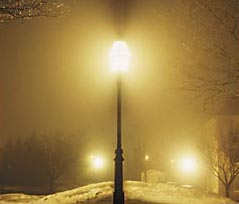Every time I speak to an astronomy gathering somewhere, I ask who in the audience is a member of the International Dark-Sky Association. The IDA, as you perhaps already know, is leading the fight worldwide against light pollution. So naturally you'd think that, among people who jump at the chance to see the summer Milky Way arc overhead, virtually everyone would raise their hands when I ask. But you would be mistaken. Invariably only a handful of arms go up. Everyone else just squirms uncomfortably.

Night lighting has become a way of life. Our round-the-clock society demands that outdoor spaces be lit up for safety and security. But bigger and brighter lights do not equate with a safer nighttime environment — good lighting design is the key.
J. Kelly Beatty
Let's do the math. In the U.S. alone there are nearly 700 astronomy clubs, and here at Sky & Telescope we estimate that at least 200,000 people consider themselves amateur astronomers. Yet the IDA, after nearly 20 years of existence, has only 11,000 members.
Something is very wrong here. If any group could be counted upon to support the IDA, it should be those of us involved in astronomy. The spread of light pollution has robbed virtually everyone of the awe and grandeur of truly dark star-spangled skies, but we skygazers feel it most painfully.
So here's your chance to help right this wrong. From now until November 1st, the IDA is offering a one-year membership for just $20 (a $10 discount) to anyone who belongs to an astronomy club. That's about what it would cost for the gas to make a few round trips to your club's dark-sky site outside the city. Or four venti orange mocha frappuccinos. Whatever.
Joining the IDA is easy. You can do it right now using the online application, or you can download a membership form to fill out and mail in. Either way, please consider joining. (If you don't belong to an astro club, individual membership is only $30.) You might not have the opportunity or wherewithal to stand in front of your town or city officials to lobby for better outdoor lighting. But that's what the IDA's staff and representatives do every day.
As IDA cofounder David Crawford pointedly asks, "If not you, then who? If not now, when?"
Full disclosure: I proudly serve on the IDA's Board of Directors. I do that because I care deeply about preserving the starry night sky both for myself and for future generations.
 3
3
Comments
Kat
September 7, 2007 at 2:24 pm
I live just 12 miles outside of Pittsburgh, PA & 25 years ago I was able to enjoy the wonders of the aura borealis. That amazing sight is only a memory due to the proliferation of light pollution from downtown Pittsburgh.
You must be logged in to post a comment.
Bill Fusfield
September 9, 2007 at 10:11 am
"Yet the IDA, after nearly 20 years of existence, has only 11,000 members" Talk about seeing the glass half empty instead of half full! In all my years in and around various social and political reform groups I've never seen as incredible an organizer as David Crawford. He takes a cause most Americans would, unfortunatly, consider to be totally trivial, namely light pollution, and builds an organization of 11,000 members which has changed lighting ordinanaces all around the world, and yet the article laments his LACK of success? If we could get 11,000 people in this country as exercised about the War in Iraq, the troops would probably be home by Christmas!
You must be logged in to post a comment.
Robert
September 11, 2007 at 7:17 am
"here at Sky & Telescope we estimate that at least 200,000 people consider themselves amateur astronomers. Yet the IDA, after nearly 20 years of existence, has only 11,000 members."
Doing the math tells me that approximately 5.5% of amateur astronomers belong to the IDA. That's not bad. There are 80 million guns owners in this country, yet the NRA only has 4 million members. That's 5% of those you would think would have a stake in the organization.
I think educating the public is the bigger challenge, not just increasing numbers within the organization. I know the more people you have, the more effective you can be, but I don't underestimate what a handful of dedicate people can do.
The key is going to be coming up with better lighting solutions, not just eliminating lights. Unfortunately, in the world we live in today, most people are more concerned with their safety, not looking at the stars. We need adequate lighting, properly designed, that will not wash out the gorgeous sights overhead.
Like most amateur astronomers, I've seen the skies get muddier, hazier, and washed out with light pollution. And I would love to see that trend reversed.
You must be logged in to post a comment.
You must be logged in to post a comment.